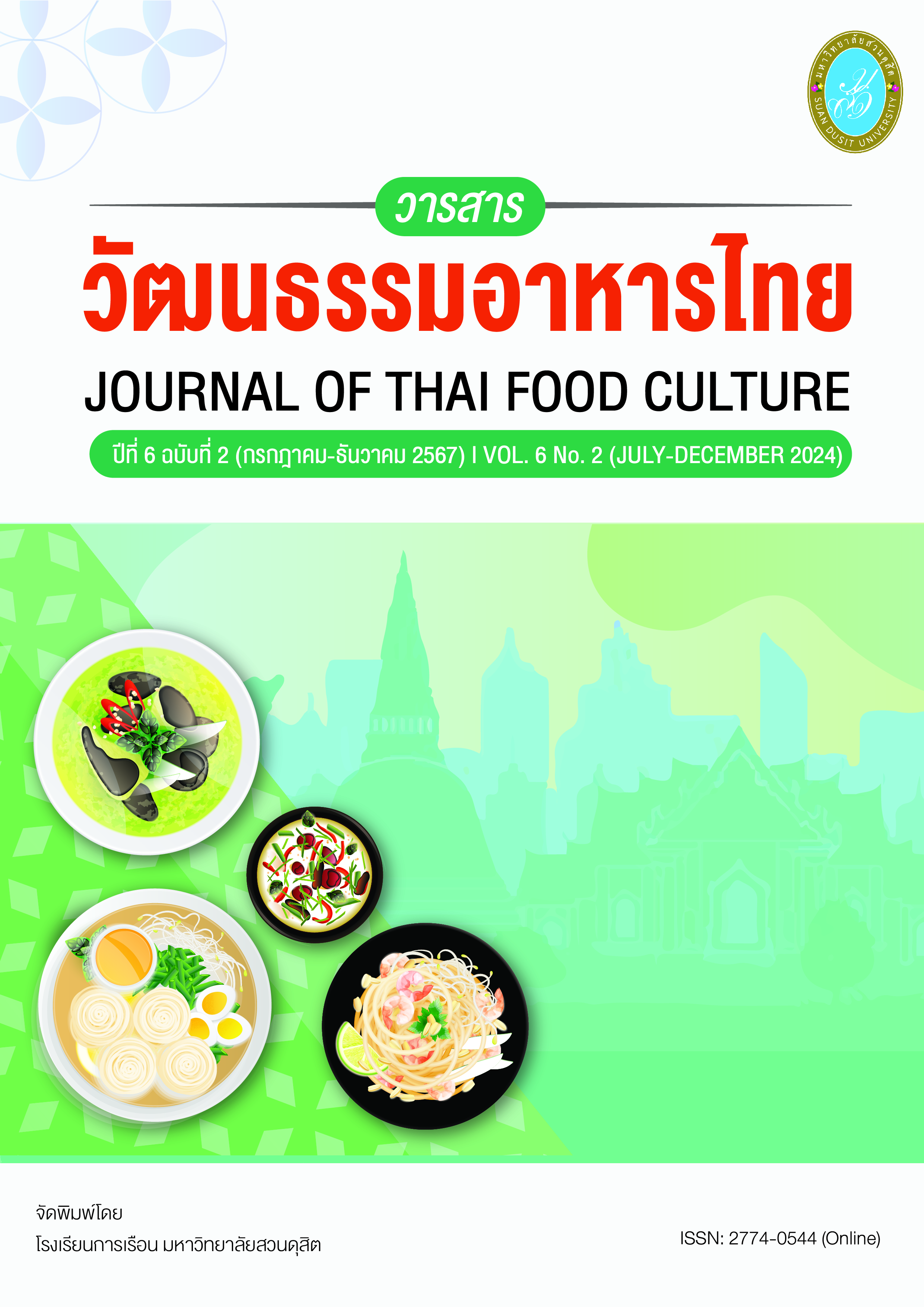From Portugal to Southeast Asia: The Journey of the Babin Bingka Bebinca
Keywords:
Desserts, Babin Bengka, Babinka, Southeast AsiaAbstract
Babin, Bengka, Babinka, Trang Province, food culture has been influenced by Portuguese, Dutch, and Chinese. Although the food has been translated as local name but the symbolism of the food is still Portuguese. This article explores the history, ingredients and cooking methods that are important in food production, type of food that is served for daily consumption, celebrations and ancestor worship as well as symbols of Portuguese, Indian-Portuguese, Dutch, Chinese mixed with indigenous Malays (Peranakan). In addition, this article discusses the factors that affect in the ambiguity of culture and food after World War II. Finally, the revival of culture through Great interest in its food, especially from the 1980s and the extent of globalization about this food. Furthermore, there is also an audit in the research results that the findings are expected to highlight the importance of food in Trang both past and present. The most important journey of Babin dessert is coconut, flour, sugar, which is similar to Babinka from the Indonesia which is widely accepted. Especially considering that Babinka of Indonesia comes from eastern Indonesia which is the closest region to the Indonesia and it has the most closely related cultures. Part of the premise comes from the Queljadas de Coimbra which is the original Portuguese and Babinca of Portugal. The Guar is from India by the nun (Babina) who invented it. That cannot connect with the Babin through the accent, but with the assumption of cultural reception from Portuguese nuns and Bika which are influenced by Orlanda that has an accent that Bika. It has a similar accent which also finds the concordance in the relationship in the VOC's trade journey with Ayutthaya and through Trang province in order to link the routes, multicultural dessert of Portugal through the journey from Bengka, Babinka and Babin.
References
ผู้จัดการออนไลน์. (2564). ขนมญี่ปุ่นเก่าแก่ที่มาจากต่างแดน, (Online). https://mgronline.com/japan/detail/9640000092748, เผยแพร่: 19 ก.ย. 2564.
พอฤทัย อดใจ และกนิษฐา ชิดช่าง. (2558). ความสืบเนื่องและการเปลี่ยนแปลงทางวัฒนธรรมของชาวไทย เชื้อสายโปรตุเกส : กรณีศึกษาชุมชนวัดซางตาครู้ส ย่านกุฎีจีน กรุงเทพมหานคร. วารสารสหวิทยาการวิจัย : ฉบับบัณฑิตศึกษา, 4(1) (ม.ค.-มี.ค.2558).
พิทยะ ศรีวัฒนสาร. (2558). บทบาทในการเผยแพร่วัฒนธรรมการกินอยู่ของชุมชนชาวโปรตุเกสในประวัติศาสตร์ไทย (Online). http://siamportuguesestudy.blogspot.com/2011/02/blog-post.html, 10 มีนาคม 2565.
วรางคณา นิพัทธ์สุขกิจ. (2555). การผสมผสานวัฒนธรรมในวิถีชีวิตของชาวกรุงศรีอยุธยา : ผลจากความเป็นเมืองการค้าของกรุงศรีอยุธยา. วารสารอักษรศาสตร์ มหาวิทยาลัยศิลปากร. 34(2): July – December 2012.
ศุภกาณฑ์ นานรัมย์. (2562). การส่งผ่านวัฒนธรรมโปรตุเกสแก่สยามกับมรดกที่หลงเหลือในจังหวัดพระนครศรีอยุธยา Potugal Cultural Transmission to Siam and Cultural Legacy in Ayutthaya Province. สาขาวิชาประวัติศาสตร์ คณะมนุษยศาสตร์และสังคมศาสตร์ มหาวิทยาลัยราชภัฏพระนครศรีอยุธยา, วารสารปาริชาต มหาวิทยาลัยทักษิณ. 32(2). (เดือนกรกฎาคม – ธันวาคม2562) มหาวิทยาลัยทักษิณ.
Barua, A. (2022). How a Nun & Lots of Leftover Egg Yolks Led to Bebinca, the ‘Queen of Goan Desserts’, (Online). Available: https://www.thebetterindia.com/253197/goa-bebinca-food-stories-zero-waste-baking-desserts-sweet-tooth-history-portuguese-delicacy-india-ana79/
Chairy & Jhanghiz S. (2019). Bika Ambon of Indonesia: history, culture, and its contribution to tourism sector. Journal of Ethnic Foods, 2019.
Ng, C. Y., Karim, A., (2016) Historical and contemporary perspectives of the Nyonya food culture in Malaysia. Department of Food Service and Management, Faculty of Food Science and Technology, University Putra Malaysia (UPM), UPM Serdung, Selangor, Malasia. Journal of Ethnic Foods, 3. 93-106.
Han, E. (2023). Queijadas de Sintra: Sintra Cheesecakes (Online). Available : https://www.thekitchn.com/ queijadas-de-sintra-sintra-che-77981
Kamaruzaman, M. Y. B., Karim, S. A., Ishak, F. a. B. C., & Arshad, M. M. B. (2020). The diversity of traditional Malay kuih in Malaysia and its potentials. Journal of Ethnic Foods, 7(1). https://doi.org/10.1186/s42779-020-00056-2
Downloads
Published
How to Cite
Issue
Section
License

This work is licensed under a Creative Commons Attribution-NonCommercial-NoDerivatives 4.0 International License.
ลิขสิทธิ์ต้นฉบับที่ได้รับการตีพิมพ์ในวารสารวัฒนธรรมอาหารไทย ถือเป็นกรรมสิทธิ์ของโรงเรียนการเรือน มหาวิทยาลัยสวนดุสิต ห้ามผู้ใดนำข้อความทั้งหมดหรือบางส่วนไปพิมพ์ซ้ำ เว้นแต่จะได้รับอนุญาตอย่างเป็นลายลักษณ์อักษรจากโรงเรียนการเรือน มหาวิทยาลัยสวนดุสิต นอกจากนี้ เนื้อหาที่ปรากฎในบทความเป็นความรับผิดชอบของผู้เขียน ทั้งนี้ไม่รวมความผิดพลาดอันเกิดจากเทคนิคการพิมพ์

